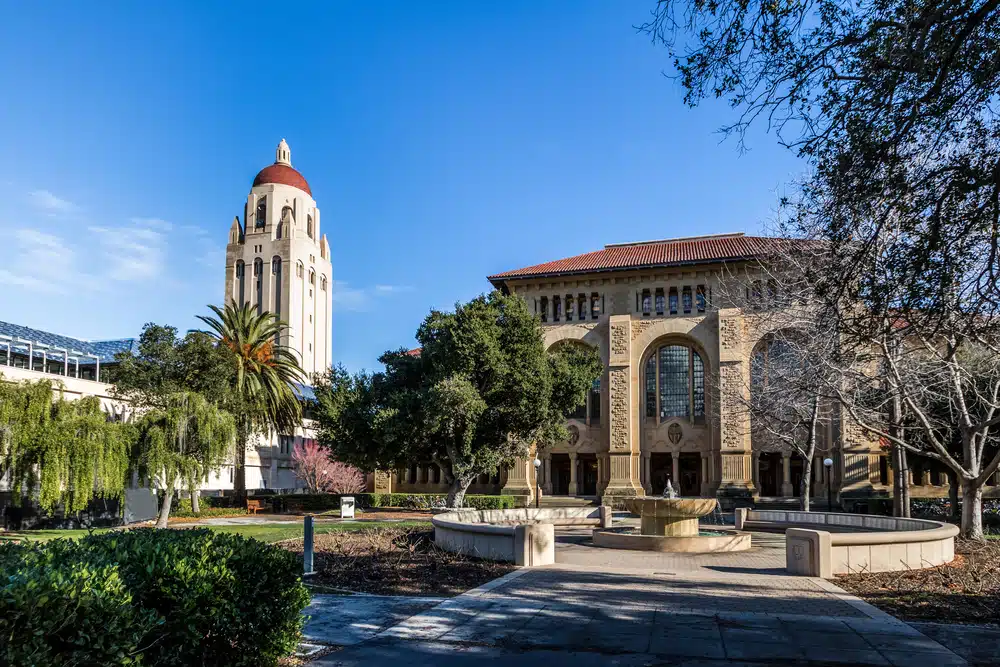Who Is the Founder of Stanford University?
When it comes to prestigious institutions of higher learning, Stanford University undoubtedly ranks among the very top. But behind its facades of red-tile roofs and sandstone archways lie stories of its inception and evolution. This article will discuss about the founder of this esteemed institution named Leland Stanford, whose foresight and vision ushered in a legacy of innovation and excellence.
The Early Life of Leland Stanford
Born in 1824 in Watervliet, New York, Leland Stanford grew up in a farming family and was no stranger to hard work. Although he was educated at home during his youth, his own educational journey was not a conventional one.
Childhood and Education
Stanford’s early education consisted of a mix of home schooling and local schools. Indeed, much of his understanding of the world was also shaped by his life on the family farm. He spent his days tending to crops, caring for livestock, and learning the value of perseverance and determination.
As Stanford grew older, his thirst for knowledge grew as well. He yearned for a broader education that would allow him to explore the world beyond the boundaries of rural New York. With this in mind, he made the decision to study law at the prestigious Cazenovia Seminary in Central New York.
At the seminary, Stanford immersed himself in the study of law, eagerly absorbing every bit of knowledge that came his way. He was a diligent student, known for his sharp intellect and unwavering dedication. His professors recognized his potential and encouraged him to pursue his dreams with unwavering determination.
Completing his studies, he then moved to Albany to study law under an established attorney. Under the guidance of his mentor, Stanford honed his legal skills and gained invaluable experience. Eventually, he earned his law certificate and started practicing in Port Washington, Wisconsin. This was where his journey from a farmer’s son to a successful businessman began.
Career Before Stanford University
Before his association with Stanford University, Leland Stanford was an accomplished entrepreneur. Following his brief stint in law, he relocated to California during the Gold Rush, hoping to strike it big. However, instead of panning for gold himself, he started a mercantile business selling supplies to miners.
Stanford’s business acumen quickly became evident as his mercantile business thrived. He had a keen eye for identifying opportunities and meeting the needs of the growing population in California. His success in the mercantile industry allowed him to diversify into other areas, including the booming railroad industry.
Recognizing the potential of railroads in connecting the vast expanses of the United States, Stanford became one of the key players in the development of the Central Pacific Railroad. Alongside his partners, he formed the famous “Big Four” and embarked on the ambitious project of building the western portion of the first Transcontinental Railroad in North America.
The construction of the Transcontinental Railroad was no easy feat. It required immense resources, strategic planning, and sheer determination. Stanford played a pivotal role in the project, overseeing the financial aspects and ensuring its successful completion. His efforts not only revolutionized transportation in the United States but also solidified his position as a prominent figure in the business world.
With his financial success and entrepreneurial spirit, Leland Stanford’s influence extended far beyond the railroad industry. He became involved in various philanthropic endeavors, including the establishment of Stanford University, which would become a testament to his commitment to education and innovation.
The Founding of Stanford University
The inspiration for founding Stanford University was a tragedy. The death of Leland Stanford Jr., the Stanford’s’ only child, from typhoid fever at the age of 15, led the mourning parents to want to do something in their son’s memory.
As they grappled with their deep grief, the couple found solace in the idea of establishing an institution that could benefit all the “children of California.” They envisioned a university that would not only provide a quality education but also serve as a catalyst for public welfare. And so, Stanford University was founded as a memorial to their beloved son, with a mission to uplift and empower individuals from all walks of life.
The Motivation Behind Its Establishment
In their quest to honor their son’s memory, Leland and Jane Stanford were driven by a profound desire to create an educational institution that would transcend social barriers. They recognized the importance of providing access to education for all, regardless of social status or background. Their vision was to build a university that would not only cater to the traditionally educated but also open its doors to those who had been denied opportunities due to societal constraints.
On March 9, 1885, Stanford University was officially established, marking the beginning of a transformative journey. The Stanford’s obtained the necessary legal permissions and set the stage for a groundbreaking educational venture that would shape the future of California and beyond.
With great anticipation, the gates of Stanford University swung open on October 1, 1891, welcoming its inaugural batch of eager students. The campus buzzed with excitement and promise as the foundations were laid for what would become one of the world’s most prestigious institutions of higher learning.
The Initial Challenges and Triumphs
Like any ambitious endeavor, Stanford University faced its fair share of challenges in its early years. High operating costs and an economic depression posed significant obstacles to the fledgling institution. However, Leland Stanford’s unwavering determination and commitment to his son’s memory fueled his resolve to secure the university’s survival.
Undeterred by the financial burdens, Leland Stanford pledged his entire wealth to ensure the prosperity of the university. His dedication and foresight attracted exceptional faculty members and meritorious students, laying the groundwork for a thriving academic community.
Tragedy struck once again in 1893 when Leland Stanford passed away unexpectedly. His death sent shockwaves through the university, and the institution faced yet another daunting financial crisis. However, Jane Stanford, a woman of remarkable resilience and strength, stepped forward to lead the university through this tumultuous period.
With unwavering determination, Jane Stanford navigated the stormy waters, steering the university towards stability and growth. Her unwavering commitment to her husband’s vision and her tireless efforts to secure the university’s future ensured that Stanford University would continue to flourish and make a lasting impact on the world.
Today, Stanford University stands as a testament to the indomitable spirit of its founders and the enduring legacy of their son. It remains a beacon of knowledge, innovation, and social progress, carrying forward the original mission to educate and empower generations of students from all walks of life.
Leland Stanford’s Vision for the University
The founder of Stanford, Leland Stanford held a progressive vision for the university he founded, wanting to instill both traditional academic values as well as a commitment to the betterment of society. His vision was clearly articulated in the founding grant of the University.
Stanford’s vision for the university was not limited to just providing a traditional education. He believed in the power of practical knowledge and its ability to shape the future. With this in mind, he declared that his university was “to qualify its students for personal success and direct usefulness in life.” This forward-thinking approach aimed to equip students with the necessary skills to thrive in the rapidly changing world.
In order to achieve this, Stanford had a novel idea of incorporating practical subjects in the curriculum, emphasizing both technical and classical education. He understood that a well-rounded education would not only provide students with a strong foundation in the humanities and sciences but also equip them with the practical skills needed to make a real impact in society.
Moreover, the University was founded with a commitment to “teach the blessings of a cultured mind and the responsibilities resting upon the citizens of a republic.” Stanford recognized the importance of community, responsibility, and citizenship in shaping the future leaders of society. These values have remained fundamental to Stanford’s ethos, with the university actively encouraging students to engage with their communities and contribute to the greater good.
The Legacy Left Behind
Leland Stanford’s philosophy and directives laid the foundation for what Stanford University represents today: a leading institution committed to the advancement of knowledge and the education of students who are expected to make meaningful contributions to society.
At Stanford’s death in 1893, he left behind a university poised to carry on his vision – an institution that has grown to be recognized globally for its excellence in education and research, thereby fulfilling Stanford’s long-term goal.
Stanford University stands as a testament to Leland Stanford’s visionary approach to education. It continues to attract top-tier faculty and students from around the world, who are drawn to the university’s commitment to academic excellence, innovation, and societal impact. The university’s rich history and vibrant campus culture are a testament to Stanford’s enduring legacy.
Today, Stanford University remains at the forefront of cutting-edge research and technological advancements. Its graduates have gone on to become influential leaders in various fields, making significant contributions to society. The university’s commitment to interdisciplinary collaboration and its emphasis on practical application of knowledge have shaped countless success stories.
As Stanford University continues to evolve and adapt to the changing needs of the world, it remains true to Leland Stanford’s original vision. The university’s unwavering dedication to academic excellence, innovation, and societal impact ensures that Stanford will continue to be a beacon of knowledge and progress for generations to come.
The Impact of Stanford University Today
Today, Stanford University is a world-renowned institution, contributing significantly to areas of research, education, and technological innovation. Stanford University, nestled in the heart of California’s Silicon Valley, has become a hub for groundbreaking research and innovation. Its sprawling campus, with state-of-the-art facilities, attracts brilliant minds from all corners of the globe. Students and faculty alike are driven by a shared passion for pushing the boundaries of knowledge and making a positive impact on society.
Contributions to Research and Innovation
Stanford University has been at the forefront of scientific breakthroughs and technological advancements. From pioneering work in artificial intelligence to groundbreaking discoveries in medicine, the university’s research has revolutionized numerous fields.
One notable example is Stanford’s involvement in the development of the internet. In the 1960’s, researchers at Stanford played a crucial role in the creation of ARPANET, the precursor to the modern internet. This groundbreaking achievement laid the foundation for the digital age we live in today.
Furthermore, Stanford’s commitment to interdisciplinary collaboration has fostered a culture of innovation. The university’s renowned centers and institutes bring together experts from various fields, encouraging cross-pollination of ideas and the emergence of novel solutions to complex problems.
This commitment to innovation can be traced back to the University’s founding principles, set forth by Leland Stanford himself. His vision was not only to create a world-class educational institution but also to cultivate an environment that nurtures creativity, critical thinking, and a relentless pursuit of knowledge.
Influence on Silicon Valley and Beyond
Stanford University’s influence extends far beyond academia and technology. It has played a pivotal role in shaping the socioeconomic landscape of Silicon Valley and has been a catalyst for global change.
The university’s close proximity to the tech industry has resulted in a symbiotic relationship, with Stanford acting as a breeding ground for entrepreneurs and innovators. Many of the world’s most successful companies, such as Google, Yahoo, and Hewlett-Packard, have roots in Stanford, with their founders being alumni or former faculty members.
Moreover, Stanford’s impact on society can be seen in fields beyond technology. The university has been a driving force in the arts, with its renowned programs in creative writing, music, and visual arts producing influential artists and performers.
Stanford’s commitment to social responsibility is also evident in its efforts to address global challenges. The university’s initiatives in sustainability, healthcare, and poverty alleviation have made a tangible difference in communities around the world.
The story of Stanford University is the story of Leland Stanford’s vision come to life – a testament to the profound impact one man’s dream can have on the world. Stanford’s legacy will continue to inspire and shape generations to come, as the university remains dedicated to pushing the boundaries of knowledge and making a positive impact on society.








































